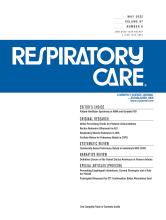Critical asthma remains a common indication for admissions into pediatric ICU (PICU) and accounts for significant morbidity in children with asthma.1 Advances in pediatric respiratory care allowed the use of a wide array of adjunctive therapies such as heliox (helium-oxygen mixture), noninvasive ventilation, and inhaled anesthetics; however, only limited pharmacologic therapies (systemic steroids, nebulized β-agonists and anticholinergics, and intravenous magnesium) have been proven effective.2 Thus, the search for the most effective current and emerging adjunctive therapy for critical asthma remains of high interest.
Adjunctive therapies are typically reserved for patients with critical asthma; however, recommendations regarding using these therapies are not standardized and remain vague, which results in wide variability in critical care provided for pediatric patients with critical asthma.3,4 This is secondary to the lack of validated and wildly available critical asthma–specific illness severity scoring and reproducible outcome measures, limiting meaningful conclusions regarding the efficacy of adjunctive therapies.4 Therefore, most studies examining adjunctive therapies for critical asthma have focused on individualized therapies rather than combination therapy delivered to patients using a standardized pathway and individualized consideration of both response to therapies and severity of illness.5
In this issue of Respiratory Care, Lew et al6 describe chronological prescribing rates of heliox for critical asthma and explore the relationship between heliox use and the frequency and duration of mechanical ventilation. Heliox is a low-cost gas mixture (21% oxygen and 79% helium molecules) that has relatively same viscosity as atmospheric air but 6 times lower density.7 The lower density of heliox decreases turbulent flow through …
Correspondence: Kyle J Rehder MD. E-mail: kyle.rehder{at}duke.edu







